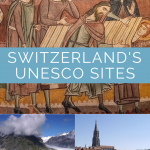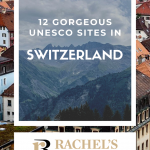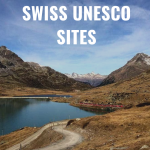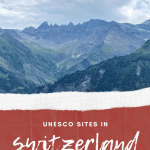UNESCO Sites in Switzerland
The following is a guest post written by Anna Timbrook.
All around the world, UNESCO promotes peace through conserving and protecting monuments, museums, and places of interest in history, science, nature, and the arts. The culture and natural beauty of Switzerland are recognized at a variety of sites from old castles to vineyards, and of course our famed watchmaking. All are packed into the tiny country’s 15,940 square miles which is roughly the size of two of the U.S.’s smallest states, Vermont and New Hampshire. This makes it easy for natives and world travelers to experience the complete list of 12 UNESCO sites in Switzerland.
Disclosure: This article contains a number of affiliate links to booking.com. This means that if you click on one and book a hotel, I will get a small percentage of what you spend. This will not affect your price.
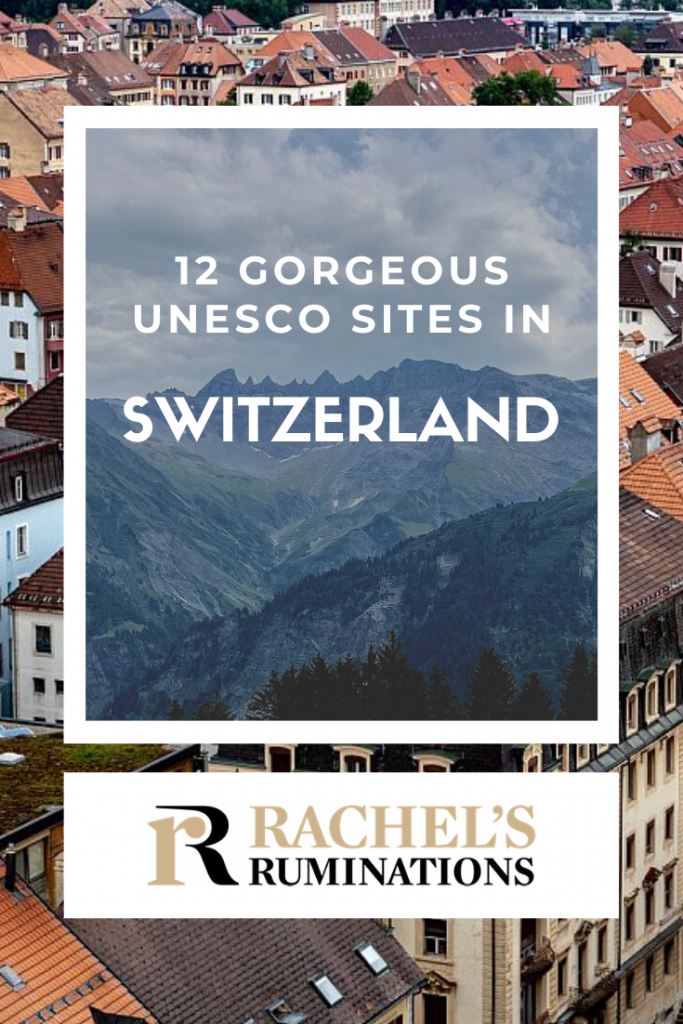
Abbey of St. Gall
The historical buildings at the Abbey of St. Gall represent 12 centuries of history with the magnificent cathedral at its heart. Dated from the 8th century, it’s Switzerland’s most cherished example of Baroque architecture and a UNESCO site since 1983. You’ll take pause at the imposing Baroque cathedral and library at the heart of the complex, and their beauty will be forever etched in your visual memory.
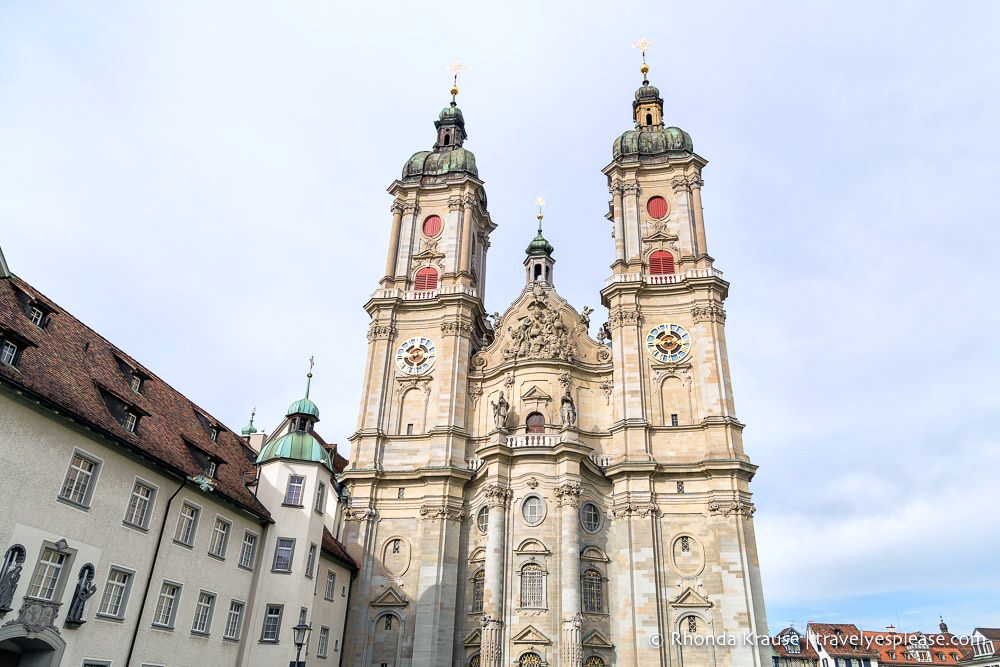
The next thrill is inside the world’s oldest and most beautiful public lending library, where precious parchment manuscripts like the oldest existing architectural plans connect you to the past.
Use this link to find accommodations near the Abbey in St. Gallen.
Benedictine Convent of St John at Müstair
Set among the stunning alpine scenery of the valleys of the Grisons, the Benedictine Convent of St John at Müstair imparts architectural history and an awareness of the political and social consanguinity of Europe for over 1200 years. The convent began as an establishment of religious Benedictines at the start of the 9th century and became a women’s abbey in the 12th century (and still is today).
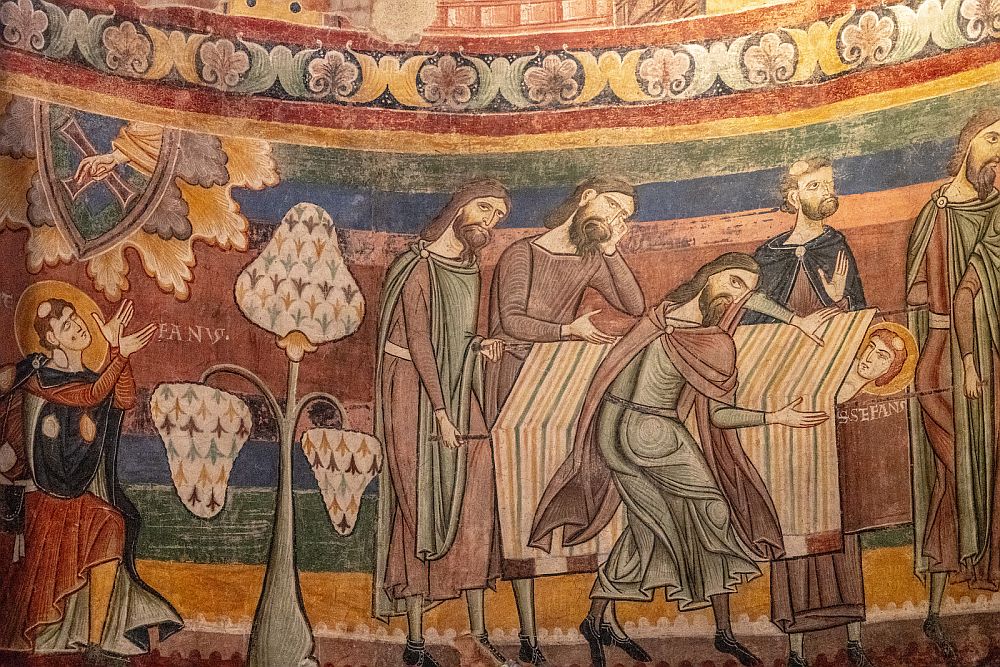
Strolling around the grounds of the convent, I was in awe of the splendid Carolingian conventual architecture. The property is comprised of the conventual church, the St. Cross Church, the ancient residences, and courtyards with cloisters and entrance towers. Inside the church, visitors will gain an awareness of Christian themes such as The Last Judgement through frescos and figurative paintings.
Old Town of Bern
Founded in the 12th century, the Old Town of Bern is Switzerland’s capital city. Its sandstone buildings replaced the wooden ones that were destroyed in a major fire in 1405. The location itself is breathtaking, situated on a hill surrounded on three sides by the river Aare. Its picturesque arcades were added in the 15th century and the magnificent fountains followed in the 16th century. The rebuilding of the medieval town in the 18th century held on to its character, helping to earn it a spot on the list of Switzerland’s UNESCO sites in 1983.
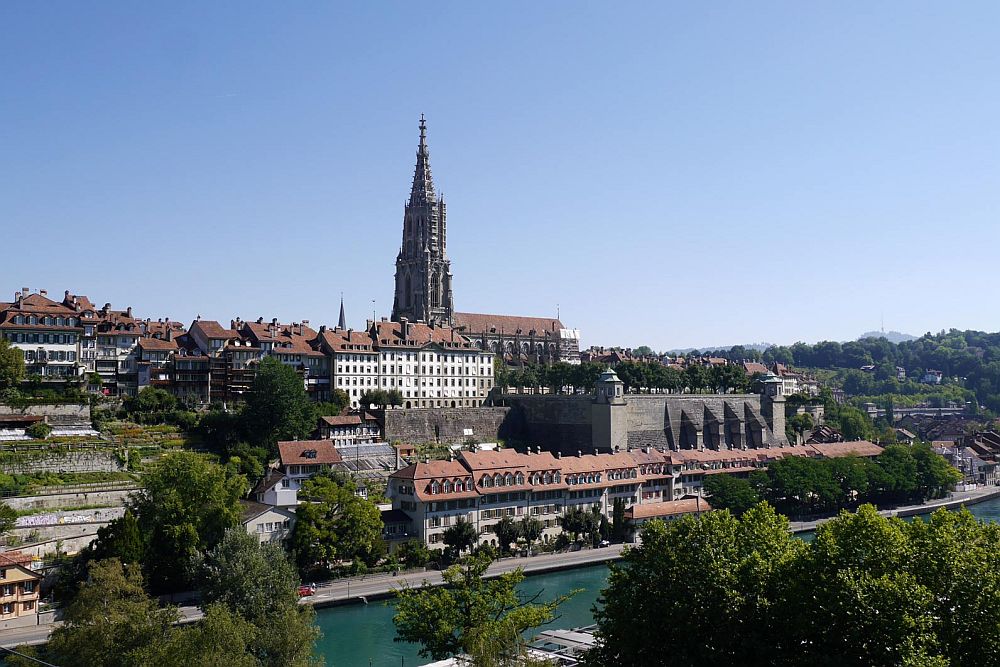
It’s fascinating to stroll the townscape which includes the famous Zytglogge (Clock Tower) and Prison Tower, as well as lots of small side streets. The Swiss Parliament is also right in the town, with a stunning view behind it of the Aare River below. There are also lots of interesting shops lining the streets, many of which are in sub-basements that are accessed via stairs from the street, a feature that is quite unique to Bern.
And don’t forget that Bern is a fantastic gateway to nearby areas like Interlaken and the Bernese Oberland.
If you’re planning to stay in Bern, use this link to book your accommodations!
Three Castles, Defensive Wall and Ramparts of Bellinzona
A combination of architecture, topography, and excellent persuasive efforts earned the town of Bellinzona the title of UNESCO site in 2000. The fusion of the rocky peak overlooking the Ticino Valley, towering castles, ramparts, and groups of fortifications will put you in sync with the ancient spirit of this Lombardy town south of the alps in Switzerland’s Italian-speaking region.
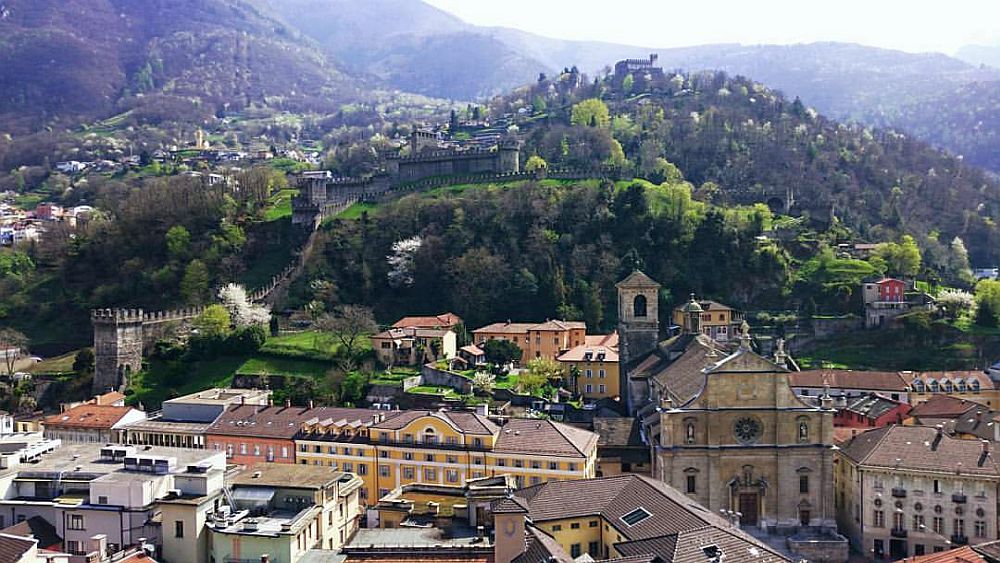
The three castles, Castelgrande, Montebello, and Sasso Corbaro, and their defensive walls closed off the valley and guarded the strategic route leading to the Saint Gotthard Pass. A small train from the Old Town takes you out to the magical spot.
For accommodations in Bellinzona, use this link.
Swiss Alps Jungfrau-Aletsch
For centuries, the world has been in awe of the mysterious splendor of the Swiss Alps through art, literature, alpine tourism, and mountaineering culture. The natural environment of the Swiss Alps Jungfrau-Aletsch region is the place on Earth where you can get a deep understanding of the unique formation of the High Alps. You’ll experience the mountain range’s most glaciated parts and the largest glacier in Eurasia. The region was inscribed as a natural World Heritage property in 2001 and has a surface area of 82,400 hectares.
There are some spectacular UNESCO sites in Czechia too. And one of the best UNESCO sites I’ve ever visited was Baalbek in Lebanon.
Not only is the Jungfrau-Aletsch region a stunning example of European geology, but it is also one of the most scenic areas of Switzerland to visit. If you are touring the country, you will likely end up in Interlaken or Grindelwald, right in the center of it all. As such, a trip up to Jungfrau is an absolute must, with jaw-dropping views and a train ride through the center of the Eiger mountain as one of the highlights. There is also year-round snow and lots of fun, related experiences to be had while you are at the highest train station in Europe.
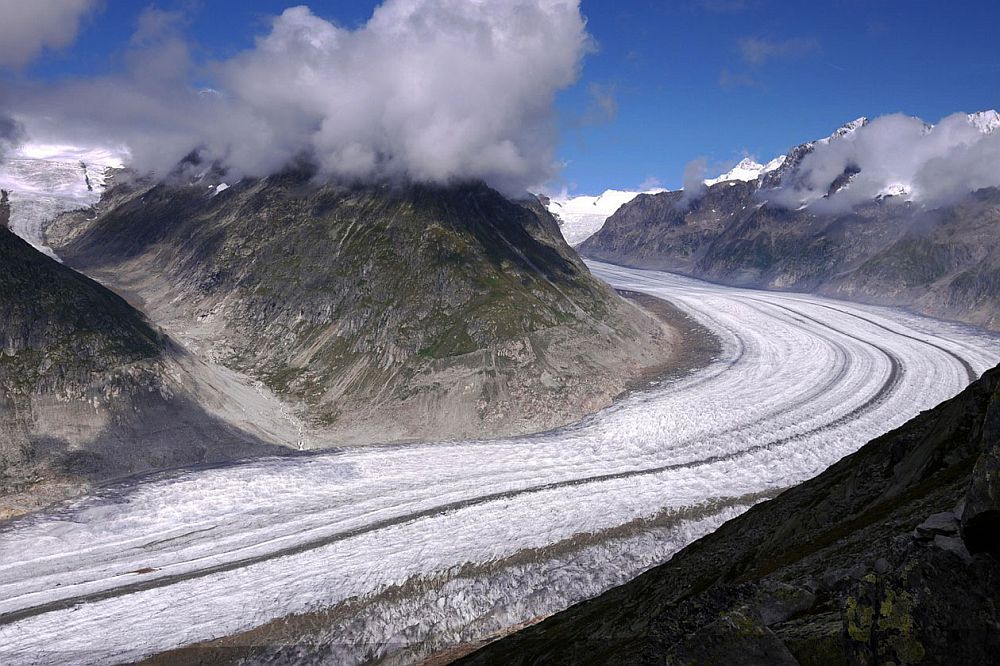
A visit to the Aletsch Glacier is also a worthwhile experience, not only because of the amazing scenery, but because it is the longest glacier in Europe, at 23km or 14 miles. I have experienced it from a number of angles including the top of Bettmeralp, and a fun hike through a short tunnel under the mountain from just below Bettmeralp. You can also do the panoramic trail along the length of the mountain, which will give you hours of amazing views.
To find a hotel near Aletsch Glacier, use this list.
Monte San Giorgio
Millions of years before the Monte San Giorgio became one of Switzerland’s UNESCO World Heritage sites in 2003, the area in the south of Ticino was an ocean basin around 100 metres deep. The fossilized plants, fish, and other animals left behind tell stories from as long ago as 245 million years.
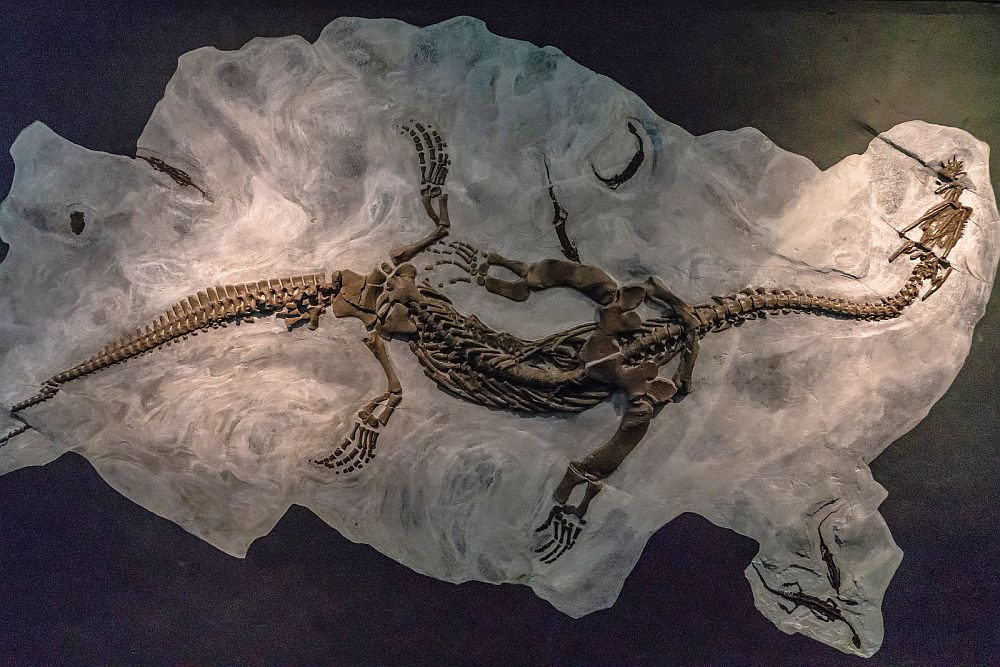
The palm-lined southern end of Lake Lugano and the distant jagged alpines is an outstanding setting for exploring excavations. Take a stroll through lush vineyards on the south slope of the mountain and visit the quaint town of Meride.
Lavaux Vineyard Terraces
The lush vineyard terraces along the south-facing north shores of Lake Geneva are rich in scenery and wildly popular for wine treks, tours, and tastings. But the region has a much deeper meaning as recognized by UNESCO in 2007. It appears there’s evidence that vineyards were grown here in Roman times. The Lavaux Vineyard Terraces can be traced back to the 11th century. They’re considered as a remarkable ecological and agricultural connection to an extensive past. The land, then and now, produces a world-class product.
If you’re thinking of moving to Switzerland, read this article first: 10 things to know before moving to Switzerland.
If you’re planning a trip to Switzerland, you’ll be able to visit some of these UNESCO sites into this Switzerland itinerary.
I have had the opportunity to visit the vineyards up close and from afar, both hiking and while driving and on the trains. The Lavaux Vineyards are very hard to miss when you journey along Lake Geneva between Lausanne and Montreux. So, even if that is all you see, it’s worth heading here just for the views. Especially since opposite the vineyards are spectacular mountains, including those around the famous spa town of Evian.
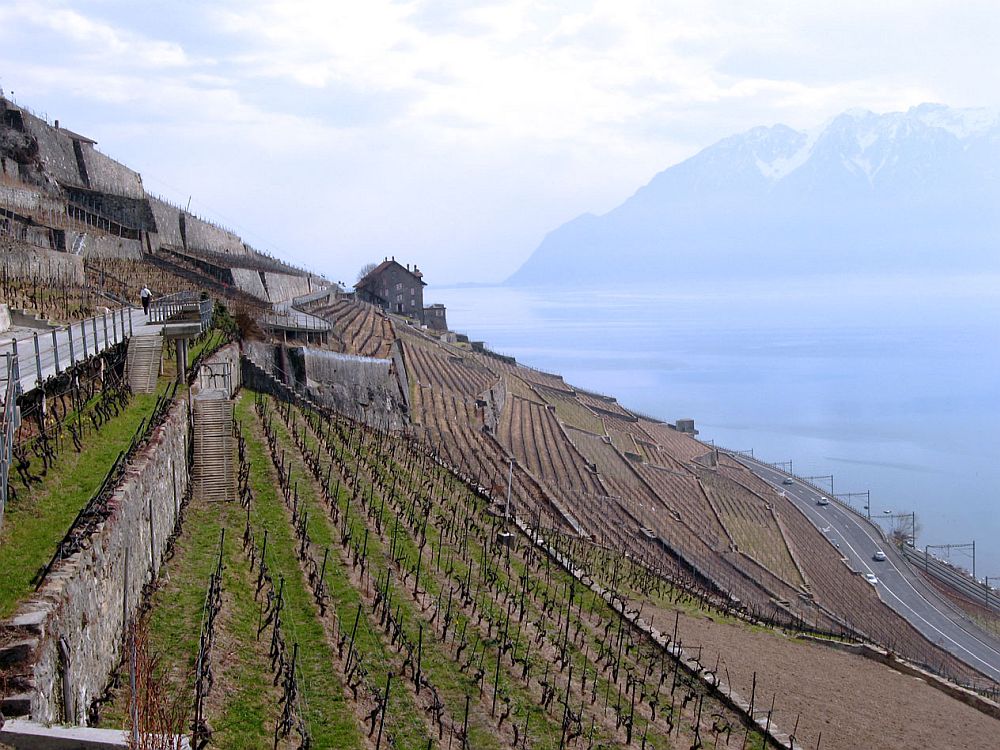
However, you can also head into some of the smaller towns around here to experience the so-called caves (cellars) and carnotzets (traditional bars). There is even a specific event each year, normally in late May or early June, where you can sample wines all around the region – it’s called the Vaud Open Cellar Days, and it’s definitely worth putting on your calendar.
Stay in accommodations near the vineyards.
Rhaetian Railway in the Albula/Bernina Landscapes
A ride on the Rhaetian Railway through the postcard landscapes of Albula and Bernina is worthy of any bucket list. The railway is also a prime example of advances in railway construction at high altitudes during the early 20th century. Not only is the Rhaetian an amazing ride, the legendary red trains that have run between Thusisto and Tirano since 1889 are a result of technology, economists, and ecology coming together, earning it UNESCO recognition in 2008.
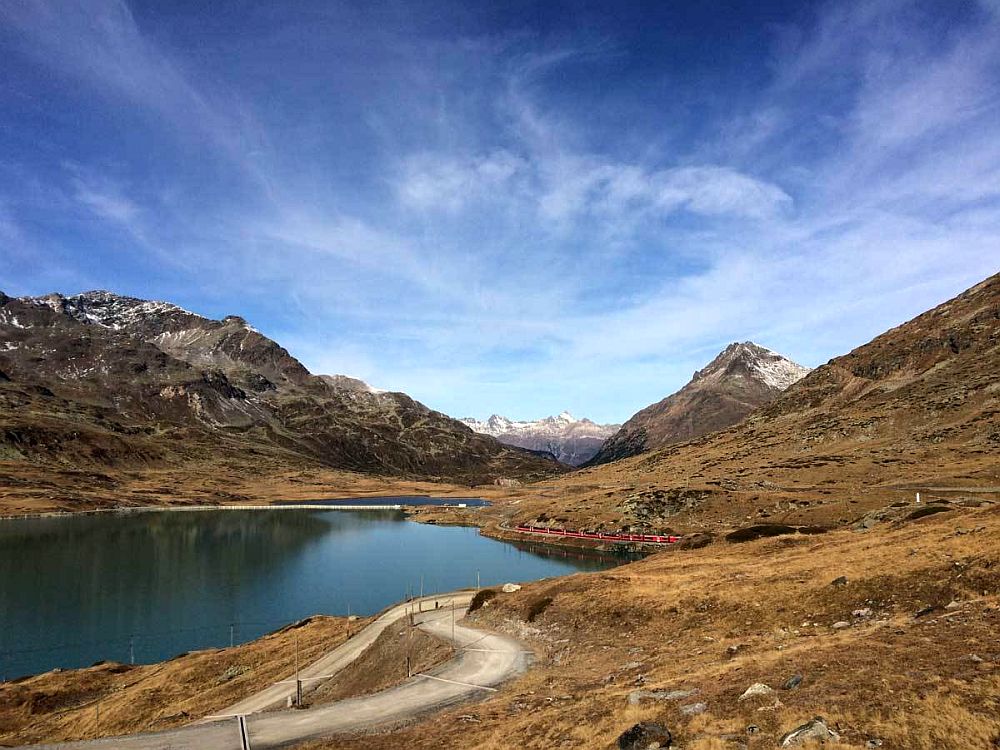
As someone who has lived in Switzerland for nearly 20 years, for me these trains are a way of life. I have used them to get to various parts of the country, usually to do hikes or weekend trips. They are a stunning way to get around, showing you various areas that are often overlooked. And on top of that, the engineering that was used to create the tunnels can be experienced both on the train and alongside it. So, if you are in the area, be sure to do some walking around the trains as well, especially near the spectacular viaducts that are iconic and unforgettable.
Stay in Thusis, at one end of the railway line, or just over the border in Tirano, Italy, the other end of the line.
Swiss Tectonic Arena Sardona
In addition to spectacular views and challenging hiking opportunities, the Swiss Tectonic Arena Sardona offers a lesson in geology. Declared as a UNESCO World Heritage site in 2008, the region covers a small part of northeastern Switzerland in a mountainous area of 32,850 hectares featuring seven peaks over 3,000 meters tall. The 3-D exposure of the rocks below provides an understanding of the geological history of the formation of the Alps.
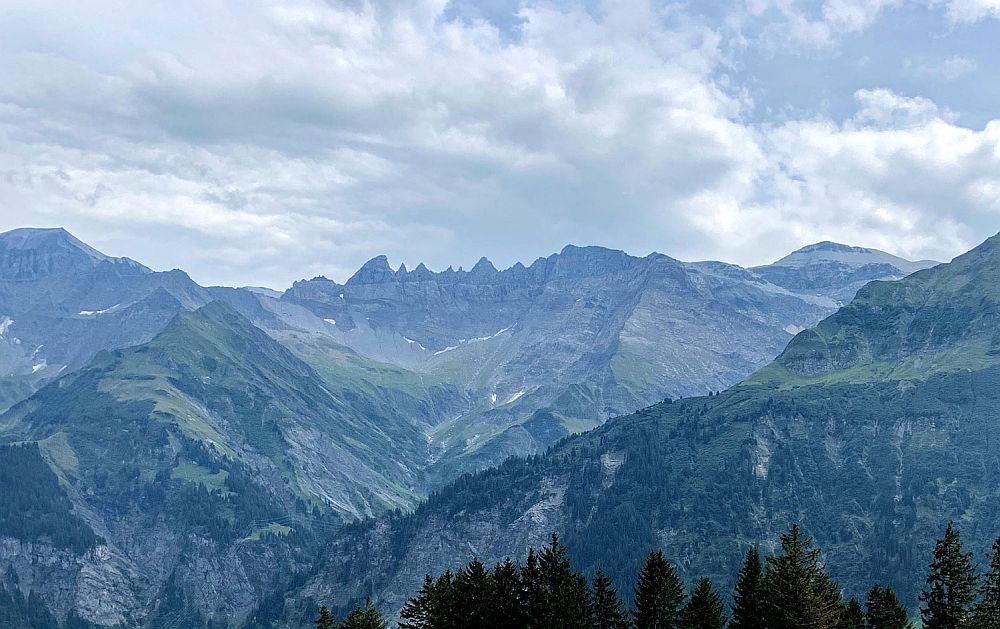
Chairlifts can get you there from the nearby town of Flims Laax to explore the area, and local expert guides can explain how the tectonic shifts and forces of nature build mountains. You can also experience it from a distance via another ski resort, Elm, which is a far quieter area in Switzerland. And one of the most unique experiences here is the two times of the year when the sun shines directly through the hole in the rocks, Martin’s Loch.
I have enjoyed this area from both sides of the mountains on various occasions on many hiking, snowshoeing and ski trips over the years. So, even if you are not into geology specifically, you can have a fantastic experience here any time of the year.
Find your accommodations in Flims or Elm.
La Chaux-de-Fonds / Le Locle, Watchmaking Town Planning
Watchmaking has been an important part of Swiss history and culture since the 13th century. La Chaux-de-Fonds and Le Locle are twin manufacturing towns given World Heritage status in 2009. It’s based on the fact that after both towns were destroyed by fire in 1794, the citizens collaborated to turn a region not suitable for farming into towns around a plan that intermingled residential dwellings with watchmaking shops.
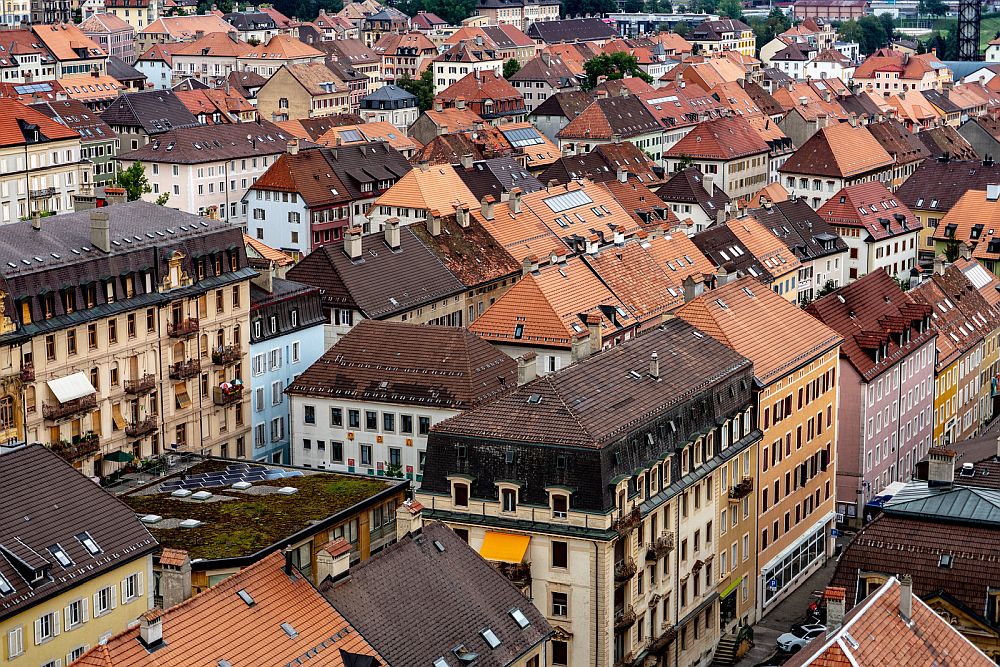
Both towns have clock museums as well as art museums, not to mention exceptional views of the Juras.
Hotels in La Chaux-de-Fonds. Hotels in Le Locle.
Prehistoric Pile Dwellings around the Alps
The remains of prehistoric settlements have been discovered in over a hundred pile dwellings in six countries that connect to the Alps. More than half of them are scattered along lakeshores, riverbanks, and wetlands in Switzerland. Excavations have shown evidence of civilization as far back as 5000 B.C. The locations were declared a World Heritage Site in 2011 and are protected by UNESCO.
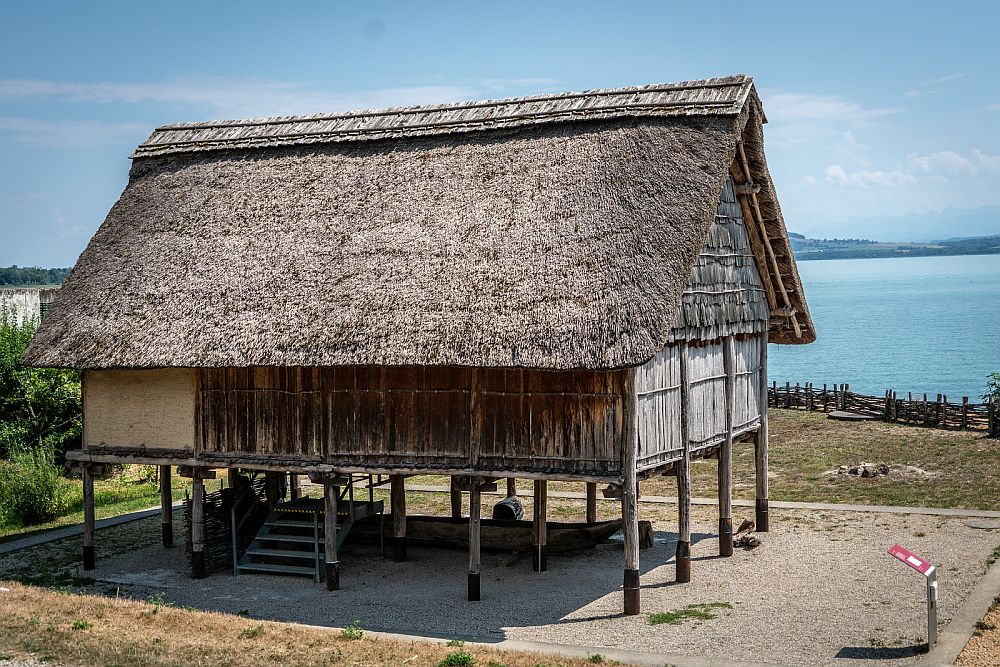
One archeological park to visit is the Laténium in Hauterive situated on the shores of beautiful Lake Neuchâtel. The museum focuses on the pile dwellings. Get there by car, train, bus or hiking.
The Architectural Work of Le Corbusier
Seventeen structures were chosen around Europe as World Heritage sites by 2016 to showcase and celebrate the works of the great Swiss-French architectural genius Charles-Édouard Jeanneret, better known as Le Corbusier. A representative of the Modern Movement, Le Corbusier nationalised architectural techniques to enhance the expanding needs of modern society. The buildings are labeled as transnational serial properties and two of them are in Switzerland. One is the Villa “Le Lac”, a residential building situated on the shore of Lake Geneva in Corseaux. The other is the Clarté building, an apartment complex located at Rue Saint-Laurent 2-4, 1207 in Geneva. Stroll by them, take photos, and see why the buildings are designated as Swiss Cultural Properties of National Significance.
Hotels in Corseaux. Hotels in Geneva.
Please share this on Pinterest or any social media!
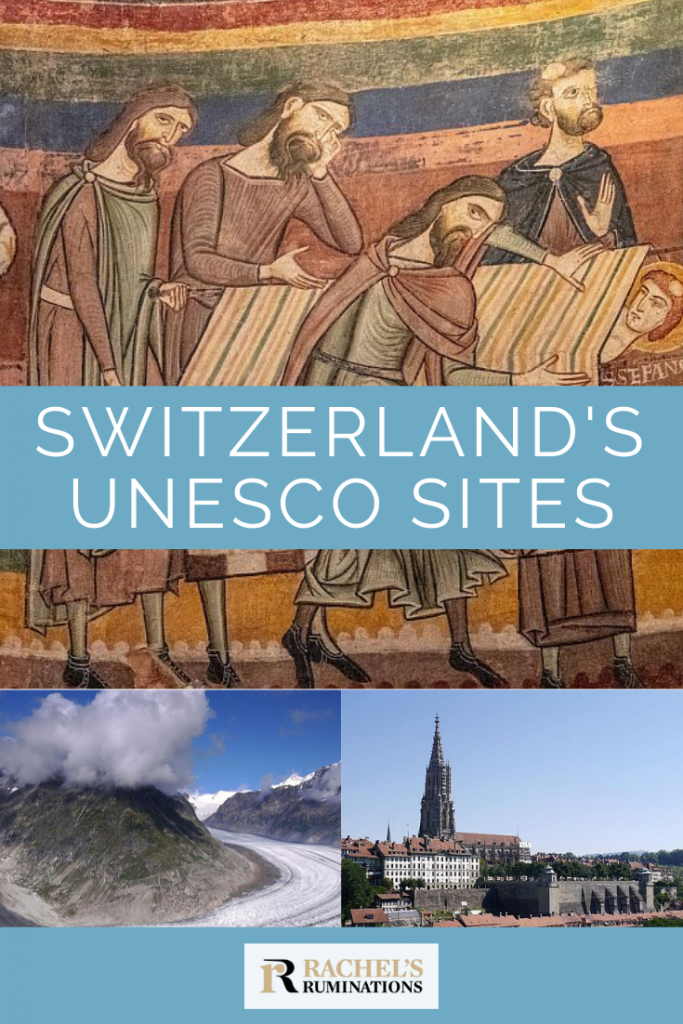
My travel recommendations
Planning travel
- Skyscanner is where I always start my flight searches.
- Booking.com is the company I use most for finding accommodations. If you prefer, Expedia offers more or less the same.
- Discover Cars offers an easy way to compare prices from all of the major car-rental companies in one place.
- Use Viator or GetYourGuide to find walking tours, day tours, airport pickups, city cards, tickets and whatever else you need at your destination.
- Bookmundi is great when you’re looking for a longer tour of a few days to a few weeks, private or with a group, pretty much anywhere in the world. Lots of different tour companies list their tours here, so you can comparison shop.
- GetTransfer is the place to book your airport-to-hotel transfers (and vice-versa). It’s so reassuring to have this all set up and paid for ahead of time, rather than having to make decisions after a long, tiring flight!
- Buy a GoCity Pass when you’re planning to do a lot of sightseeing on a city trip. It can save you a lot on admissions to museums and other attractions in big cities like New York and Amsterdam.
Other travel-related items
- It’s really awkward to have to rely on WIFI when you travel overseas. I’ve tried several e-sim cards, and GigSky’s e-sim was the one that was easiest to activate and use. You buy it through their app and activate it when you need it. Use the code RACHEL10 to get a 10% discount!
- Another option I just recently tried for the first time is a portable wifi modem by WifiCandy. It supports up to 8 devices and you just carry it along in your pocket or bag! If you’re traveling with a family or group, it might end up cheaper to use than an e-sim. Use the code RACHELSRUMINATIONS for a 10% discount.
- I’m a fan of SCOTTeVEST’s jackets and vests because when I wear one, I don’t have to carry a handbag. I feel like all my stuff is safer when I travel because it’s in inside pockets close to my body.
- I use ExpressVPN on my phone and laptop when I travel. It keeps me safe from hackers when I use public or hotel wifi.


